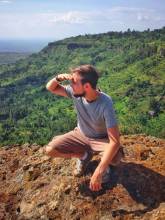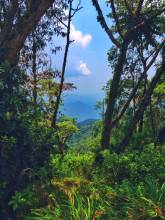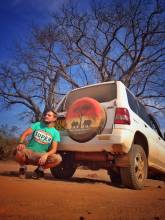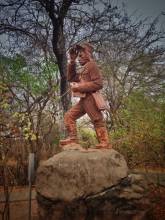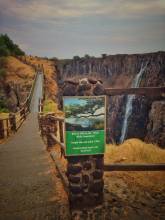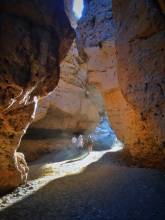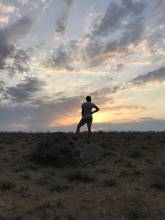Top sights off the beaten path in Western Tanzania
Western Tanzania is a living example of how tourism works. The three famous sights are concentrated in the North-West and it makes it the most developed part of the country. Typically people visit Kilimanjaro, Zanzibar or the Serengeti, spend money there and help to develop the services by demand. The rest of the republic is in a significantly worse situation, which is a pity and that is why I decided to introduce you few spots from my expedition through the west territories worth visiting. I was ready for adventurous wilderness, but it was not bad at all.
is a living example of how tourism works. The three famous sights are concentrated in the North-West and it makes it the most developed part of the country. Typically people visit Kilimanjaro, Zanzibar or the Serengeti, spend money there and help to develop the services by demand. The rest of the republic is in a significantly worse situation, which is a pity and that is why I decided to introduce you few spots from my expedition through the west territories worth visiting. I was ready for adventurous wilderness, but it was not bad at all.
Lake Tanganyika
Lake Tanganyika is so huge, it is visible from the outer space. It is actually the longest lake with fresh water and even with a number of islands belonging to the four countries surrounding this formation, Burundi, Tanzania, Congo and Zambia . With my schedule, I got to drive along the whole length of the lake and I even enjoyed a swim while stopping at Liemba Beach Resort. An old German battleship called MV Liemba was built in order to operate on this very lake during the First World War and these days it serves as a cruiser. It actually figured in a novel The African Queen as the gunboat Luisa. The lake has another interesting phenomenon to attend and it is a number of endemic species. Even as a laic you can find various shells of marine-like shaped freshwater snails that survived coexistence with snail eating fish thanks to their often spiky shells.
. With my schedule, I got to drive along the whole length of the lake and I even enjoyed a swim while stopping at Liemba Beach Resort. An old German battleship called MV Liemba was built in order to operate on this very lake during the First World War and these days it serves as a cruiser. It actually figured in a novel The African Queen as the gunboat Luisa. The lake has another interesting phenomenon to attend and it is a number of endemic species. Even as a laic you can find various shells of marine-like shaped freshwater snails that survived coexistence with snail eating fish thanks to their often spiky shells.

Mahale Mountain National Park
This national park is called after Mahale Mountain massive in its center. Its area is enormous and in addition to those mountains it also consists of jungle and long coastline. It is an undistorted chunk of wilderness that was previously inhabited by people of Holoholo tribe living in absolute harmony with Mother Nature. Unfortunately, this tribe with just little over ten thousand members, was forced by the authorities to leave their territory on behalf of the national park during the early eighties. If we take into account the fact that this step completely destroyed the development of their culture and of their homes, just in order to make this area a tourist attraction, it is very surprising that the national park has not been promoted more. Quite unique is the concept of no roads in there, therefore you can only use a boat or walk, which requires a good planning so you do not get lost. The place is famous for the chimpanzee sanctuary and the cohabitation of the apes with lions and tigers. You can also spot crocodiles and hippopotamuses in the river. Western Tanzania is one of the more challenging and you should be a competent traveller to go deep into it.
Katavi National Park
This national park is as well pure nature inhabited heavily by animals. To overcome dirt road along the lake and explore the beauties of the real savannah pays off especially in the dry season, when the animals cluster around remaining water sources and create a movie-like spectacle. Herds of antelopes, zebras and bison gallop through the vast flat plain, allowing you to watch each movement up to the horizon. Visitors are sometimes urged to stay overnight in official camps in cabins because of the danger caused by the wild beasts like lions. The cabins are cozy and affordable and you can even get some food there. The best thing about the one, where I stayed, was is how close it was to a place where hippopotamuses go drink water. They are big and deadly creatures, but amazing to watch. On the edge of the park, there is a Lake Rukawa with salt water. With no flowing source of water, just rain, its level fluctuates so much that sometimes it gets split into two smaller ponds. It is not really accessible, except for by 4WD and it is not adapted for visitors. Consider thoroughly before going there if you are really ready, Africa has more approachable stunning places.
has more approachable stunning places.

Southern Highlands
Amazing sceneries of the Southern Highlands are livened up by the green areas of fields and plantations. They mostly grow coffee plants as they thrive there. Agriculture is the main source of income in this area and it somehow goes hand in hand with roads, a bit more of infrastructure and various facilities in the region. One of the most alluring site of the region, though, comes from outer space. The colossal Mbozi Meteorite weighs 16 tons and is still in one piece, only few tiny samples were taken for scientific purposes. As an unforgettable experience, I would list my camping right on the heliport of a luxury lodge. A former coffee plantation was remodelled to host luxury adventurers on their trip across the country. Sleeping on the empty heliport right next to the unused tennis court was a much more authentic experience though. And the best of it all, it saved me a lot of money while being able to use all the lavish infrastructure.
This part of the world is only for seasoned travellers that are ready to risk a bit and face the vast nature in its pure form. Do not expect infrastructure, restaurant or somebody helping you at every corner. However, with a little of ahead planning, good gear and preferably good vehicle, Western Tanzania is doable and for sure it will become a lifelong experience. The Lonely Planet quite helped me out while searching for accommodation.



